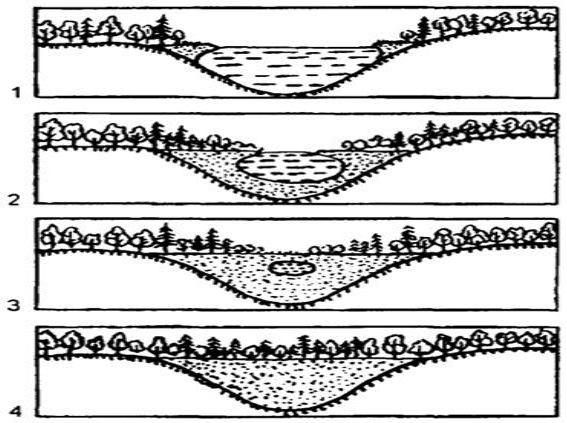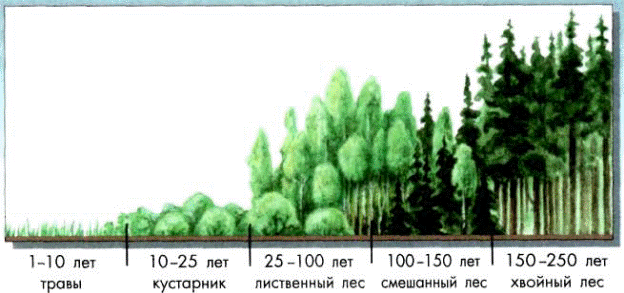Ecological succession
Ecological succession
One of the main achievements of ecology was the discovery that not only organisms and species develop, but also ecosystems. Communities are constantly changing. Some organisms die, others come to replace them. Energy and nutrients flow through the community in an endless stream.
Concept and types, 2018.
The sequence of changing communities (ecosystems, biocenoses) in the same territory called succession.
There are three points to keep in mind when determining ecological succession.
First, the succession takes place under the influence of the community, i.e. biotic component of the ecosystem.
Secondly, the succession is directed in a certain way and it can be predicted (foreseen).
The third aspect is that the culmination of succession is the emergence of a stabilized ecosystem, in which the maximum biomass and the maximum number of interspecific interactions are accounted for per unit of energy flow.
The final stage of succession is called climax community.
Traditionally, the process of succession is illustrated by the example of overgrowing of a small reservoir in a forest (Fig. 34). Above-water parts of plants of coastal herbaceous vegetation die off every year, which reduces the area of the clear water of the pond.

Gradually, near the coast, conditions are formed that are favorable for the development of more powerful coastal plant species, such as willow. Taking root, the willow begins to pump out water from the pond, draining the area of its existence. As a result, willow is replaced by small-leaved tree species: birch, hazel.
Concept and types, 2018.
The area of the pond surface continues to decrease, soil moisture decreases, and forest soil begins to form. Small-leaved trees are replaced by broad-leaved trees, oaks and lindens gradually appear, various shrubs and herbaceous plants develop under their crowns. Conditions are gradually being created for the introduction of coniferous trees into communities. As a result of the excessive intake - together with organic matter - of biogenic chemical elements, mainly nitrogen and phosphorus, into the reservoir, water “blooms”: unicellular algae multiply in huge quantities. “Aging” of lake ecosystems is taking place - their eutrophication.
Dying algae, together with foraminifera, fall "rain" to the bottom, which leads to a decrease in the depth of the pond. As a result, a forest is formed on the site of the reservoir, which actually does not differ from the one that surrounded the reservoir several decades ago. Under certain external conditions, the lake turns into a peat bog, which is a stable ecosystem of the climax type.
There are a very large number of succession classifications.
Depending on the reasons for the succession, there are
· exodynamically e (from the Greek word exo - outside) successions caused by factors external to this ecosystem,
· endodynamic(from the Greek word endon - inside) successions caused by the internal mechanisms of the ecosystem
Exodynamic successions can be caused by climate change, a decrease in the level of groundwater, a rise in the level of the world ocean, etc. Such shifts can last for centuries and millennia. They are mainly associated with the action of the mechanisms of adaptation of the ecosystem to environmental factors, which in turn are based on the mechanisms of adaptation of living organisms of the ecosystem.
Endodynamic successions are set in motion by special laws, the mechanisms of which are still largely incomprehensible. It is known that on any, even absolutely lifeless, substrate such as sand dunes or solidified lava, life sooner or later flourishes. At the same time, the forms of life, more precisely, the types of communities, in a given space successively replace each other, gradually becoming more complex and increasing the species diversity, forming the so-called succession series, consisting of successive stages marking the replacement of one community by another.
The succession series ends with a maturity stage at which the ecosystem changes very little. Ecosystems at this stage are called climax(from the Greek word climax - staircase).
The duration of the succession from the emergence of the ecosystem to the climax stage can be up to hundreds and even up to thousands of years. Such a long duration is mainly associated with the need for the accumulation of nutrients in the substrate.
There is another type of succession classifications.
Distinguish autotrophic and heterotrophic successions... All autotrophic successions occur in ecosystems where vegetation (phytocenosis) is the central link.
The dynamics of heterotrophs is entirely subordinated to the dynamics of autotrophs - the change in animal communities depends on the change in plant communities. Autotrophic successions can theoretically last forever, as they are constantly fueled by the energy of the Sun.
V heterotrophic successions only animals are involved (heterotrophs, consumers). This process can also involve dead plants, for example, fallen trees, stumps, etc., which are, as a rule, a source of energy for heterotrophic succession.
Heterotrophic succession presupposes the obligatory presence of a certain amount of energy accumulated in organic matter. It ends with the depletion of the energy resource, that is, after the complete decomposition of the original substrate. After this, the ecosystem ceases to exist. Thus, the concept of menopause is not defined for her. Unlike biogeocenoses, such ecosystems are mortal.
Examples of heterotrophic succession are changes in communities on a corpse of an animal (changes occur in approximately the following order: bacteria - ants - dead-eating beetles, skin-eating beetles, lice-eating beetles); on a pile of manure (or dung); on the remaining fruit lying on the ground - an apple, for example.
Posted on ref.rf
The longest heterotrophic succession is observed on the trunk of a large fallen tree.
Thus, in heterotrophic succession, there is no climax stage.
Heterotrophic succession is well associated with a society dependent on fossil fuels. The dynamics of heterotrophic succession is described by a curve with a rapid increase in the number of organisms until a certain maximum is reached, then the number of organisms gradually decreases as the energy resource is exhausted. It is not possible to achieve any stable state (climax). Such a society is rapidly progressing, but nevertheless it is initially doomed to extinction.
We have already skimmed the cream off most of the fields. Their further operation over time will require more and more energy investments. Therefore, the efficiency of mining will steadily decline. Along with this, the viability of a civilization built on a heterotrophic succession will also decline, unless, of course, catastrophic changes occur even earlier. Therefore, we devote a huge amount of effort to finding new sources of energy. But even if we learn to control thermonuclear fusion, this will not change our destructive nature.
Depending on the initial conditions, the succession is subdivided into
- primary(when organisms colonize empty areas that have never been inhabited before) and
- secondary(the process takes place in places that have already been inhabited, but have lost their inhabitants as a result of, for example, glaciation or human activity).
Primary succession- the process of development and replacement of ecosystems in previously unpopulated areas, starting with their colonization.
A classic example of primary succession is the development of a community on cooled lava or ash in the zone of volcano action, on rocks and stones. Lichens initially appear, enriching the surface with nitrogen.
Concept and types, 2018.
After a while, mosses begin to develop in the biotope. After this, grass grows along with mosses, then small-leaved trees. It is not difficult to notice that all this time the soil develops in the ecosystem, making possible the growth of all more complex organisms.
Secondary succession occurs where the biocenosis previously existed, but it was destroyed as a result of natural or anthropogenic factors.
For example, the secondary succession begins at the sites of deforestation, on abandoned arable land, in abandoned villages, after natural disasters: floods, tsunamis, forest windblows, earthquakes. The study of pyrogenic (resulting from fires) successions acquires a special meaning, since with the development of human society, the proportion of fires caused by humans increases.
Secondary succession ends with a stable community stage after 150-250 years and primary lasts about 1000 years.
4.2.1 Climax ecosystem.
The succession ends with a stage when all species of the ecosystem, while multiplying, retain a relatively constant number and no further change in its composition occurs. This equilibrium state is called menopause, and the ecosystem is called climax. In different abiotic conditions, different climax ecosystems are formed. In hot and humid climates, it will be a rainforest rainforest, in a dry and hot climate it will be a desert. The main biomes of the earth are the climax ecosystems of their respective geographic areas.
Yelnik is the last climax stage in the development of the ecosystem in the climatic conditions of the North, that is, already the root biocenosis (Fig. 33).

Rice. 33. Consecutive successions during the formation of a spruce forest.
Initially, the so-called pioneer species, such as lichens and crustal algae, settle on a lifeless substrate). For 5-10 years, they somewhat enrich the substrate with nutrients, forming the rudiments of the soil. Further, on these still very poor soils, grasses settle, further enriching the soil. About 15 years after the beginning of the succession, the first shrubs settle on the once lifeless space, which are gradually replaced by deciduous light-loving trees, most often birch and aspen, which are characterized by rapid growth.
Concept and types, 2018.
By the age of 50, in a young deciduous forest, the strongest trees stand out, which shade weaker shoots, which die, making it possible for spruce shoots to settle under the canopy of a deciduous forest. Spruce is more shade-tolerant, under the protection of deciduous trees, it gradually catches up with them in growth, recapturing their living space. By the age of 70, the ecosystem reaches the stage of a mixed spruce-deciduous forest. Deciduous trees have time to grow old by that time, and gradually the spruce enters the first tier, shading and thinning all deciduous vegetation. By the age of 90, this ecosystem reaches the climax stage, which is characterized by an almost complete absence of deciduous trees, spruce becomes the dominant edificator species, forming in a special way the entire life of the community inhabiting this ecosystem.
the law of thermodynamics is called the law of conservation of the structure of the biosphere).
Ecological succession - concept and types. Classification and features of the category "Ecological succession" 2017-2018.







